The STCE's SC25 Tracking page has been updated to reflect the latest evolution in some critical space weather parameters for the ongoing solar cycle 25 (SC25), from sunspot number all the way to cosmic rays. The multiple graphs allow for a comparison with previous solar cycles at similar stages in their evolution. Over the last few months, the monthly sunspot number (SILSO) has stabilized around 85. The current smoothed monthly sunspot number is still about 35% higher than what was predicted (68.9 observed vs. 50.6 predicted). IF this trend continues, then SC25 maximum will be higher than expected.

During the period June-September 2022, most of the flaring activity was generated by sunspot groups on the southern hemisphere. An example of elevated flaring activity can be found in the extreme ultraviolet imagery underneath (SDO/AIA 131), when on 28 and 29 August, active region NOAA 13088 was the source of some important flaring events such as an M6 and an M8 flare while rounding the southwest solar limb.

The effect of the enhanced solar activity of this year is also reflected in the decreasing trend of neutron counts. When galactic cosmic rays (GCR) or high-energetic (> 500 MeV) solar protons interact with particles in the Earth's upper atmosphere, the created secondary particles can reach all the way down to the Earth's surface where they can be measured by e.g. neutron monitors such as in Dourbes, Belgium. The evolution of the neutron counts anti-correlates with the solar cycle activity because during periods of increased solar activity, the turbulent solar wind and the continued series of coronal mass ejections provide sort of a magnetic shield against the GCR, and neutron counts are low. During solar cycle minimum, this magnetic barrier is much less prominent allowing the GCR an easier access to the earth environment and thus resulting in elevated neutron counts. The graph below shows the evolution of the (unsmoothed) monthly neutron count (counts/minute ; corrected for air pressure and efficiency) as monitored by the Cosmic Rays station of the University of Oulu, Finland.. This station has one of the longest running databases for this parameter, starting in 1964. Current evolution of the neutron counts (decreasing) shows the effect of the increased solar activity of the last few months, thus keeping more of the cosmic rays away from the Earth.






